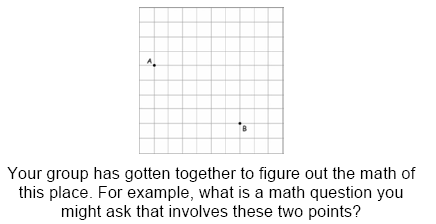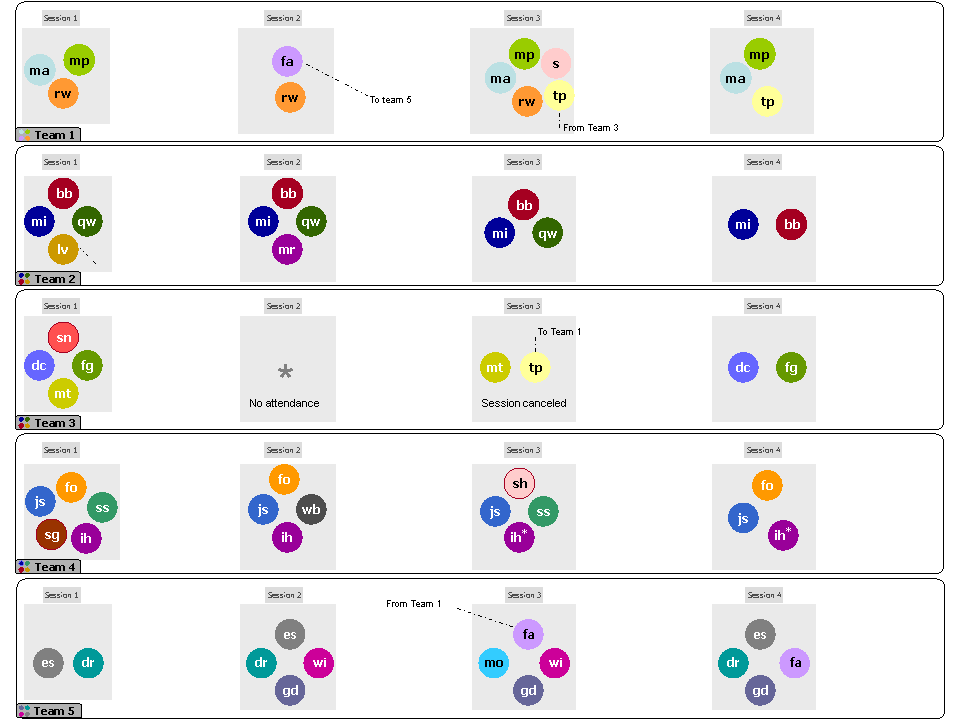Dataset1
From Jsarmi
This dataset corresponds to 18 sessions held as part of the first VTM Spring Fest in 2005.
Jump to the Report
Contents |
Summary
- Date: Spring of 2005
- Participants: Volunteer students, selected by invited teachers, grouped in 5 teams of 3 to 5 students
- Sessions: A series of 4 group chats per team lasting about one hour over a span of two weeks (Tuesday, Thursday, Tuesday, Thursday)
- Task: Open-ended mathematical task: Taxi-cab geometry
- Facilitation: A moderator was present in all sessions but tried not to participate in the math activity. Feedback was provided in between sessions
Data Sources
New VMT data site: http://vmt.mathforum.org/vmtdata/
| Team | Summary | Session 1 | Session 2 | Session 3 | Session 4 |
|---|---|---|---|---|---|
| Team 1 | Summary | Transcript - Notes 0510g1.jno | Transcript - Notes 0512g1.jno | Transcript - Notes 0517g1.jno | Transcript - Notes 0519g1.jno |
| Team 2 | Summary | Transcript - Notes 0510g2.jno | Transcript - Notes 0512g2.jno | Transcript - Notes 0517g2.jno | Transcript - Notes 0519g2.jno |
| Team 3 | Summary | Transcript - Notes 0510g3.jno | Transcript - Notes 0512g3.jno | Transcript - Notes 0517g3.jno | Transcript - Notes 0519g3.jno |
| Team 4 | Summary | Transcript - Notes 0510g4.jno | Transcript - Notes 0512g4.jno | Transcript - Notes 0517g4.jno | Transcript - Notes 0519g4.jno |
| Team 5 | Summary | Transcript - Notes 0510g5.jno | Transcript - Notes 0512g5.jno | Transcript - Notes 0517g5.jno | Transcript - Notes 0519g5.jno |
[data] (password protected)
Overarching Questions
- What are the interactional bridging methods that can be identified in these VMT online learning sessions?
- How can we effectively conceptualize these phenomena and analyze their interactional effects?
- How does bridging activity span across the teams' trajectories over time?
Goals
The central goal of this baseline design study is to reach an initial characterization of bridging phenomena and produce an initial survey of methods used by participants to engage in bridging activity. At this point, we define bridging as the interactional work that virtual math teams engage in when dealing with three specific discontinuities of their collective work: The discontinuity of their sequences of collaboration episodes (i.e. each online session they participate in), the discontinuities emerging from the different patterns of participation of individuals and collectivities (e.g. individual attendance to sessions, collective participation in relevant problem-solving work), and the discontinuities derived from diverse problem-solving perspectives brought forward during the collaborative interactions.
Methods & Procedures
The data for this study comes from 18 collaborative sessions held in the Spring of 2005 as part of the Virtual Math Teams project. Four teams of 3-5 secondary students. Recordings. The teams engaged in online math discussions for four hour-long sessions over a two-week period. We expect that the sequential nature of the mathematical tasks that will be utilized in addition to the collaborative nature of the multi-team setup will provide with a propitious setting for bridging work to be investigated.
- Team Composition and Evolution: Each team will be composed of three to four non-collocated, upper middle-school or high-school students. Participants will be recruited through the Math Forum online community and selected by volunteer teachers at different schools across the USA or abroad. To the extent possible, teams will be composed of students from different schools. Participants will use anonymous handles throughout the four sessions and will be encourage to behave in a natural way. Attendance to all sessions will be highly encouraged but because of the voluntary nature of the study and the naturalistic environment that the Math Forum entails, it is possible that changes in team composition will occur. However, we see these changes as propitious opportunities to study bridging and, as a result, they will be managed as such. Across the four sessions, we will encourage teams to stay together but changes in team membership might also occur due to attendance constraints or personal preference of the participants.
- Settings: The elements of the activity system that we expect to investigate in this study include the sequential structure of the task, the composition of the teams (as well as their development across sessions), and the online environment. We described these three elements below.
- The task: Teams will work on the “Grid world” mathematical task, which allows for both, collaborative problem finding and problem solving. In the first session, the teams will be given a brief description of this non-traditional geometry environment: a grid-world where one could only move along the lines of a grid. The students will be asked to generate and pursue their own questions about the grid-world, such as questions about the shortest distance between two points in this world.
- The online sessions where facilitated by a member of the VMT research project team. In each session, the facilitator welcomed the students to the chat, introduced the task, and provided technical assistance regarding the special features of the collaboration environment. The facilitator did not actively participate in the team’s mathematical collaboration. After the first session, the teams received feedback on their prior work and the work of other teams. The instructions for each session directed teams to continue their prior work, consider the work of other teams or pursue new questions. We expect that these aspects of the task, including the feedback given to the teams, would promote sustained problem-solving work by the teams. The analysis of the data collect would then provide us with an opportunity to validate this expectation and analyze how continuity is established in interaction. The fact that the task is open for the team to find, formulate, and purse the questions that are of interest to the participants, leads us to predict that we will be able to observe a wide range of problem-solving activity including problem formulation, problem representation, strategic .
- Online Environment:. Participating teams will use the ConcertChat virtual room environment for their interactions. ConcertChat combines a persistent chat environment with a shared whiteboard and a set of special referencing tools to reduce ambiguity when referring to chat postings or objects on the whiteboard.
Figure 2. ConcertChat collaboration environment with references from chat to whiteboard
- In this study, the teams will be provided a new ConcertChat room for each one of the sessions. Teams will not have direct access to the persistent records of their interactions from previous sessions or those of other teams and will only learn about them in a direct way through the feedback provided by the facilitators. No additional information will be available directly in the system about the members of the teams, their meetings and results. We expect that the setup of the online environment can be considered one with no explicit computational supports for bridging. ConcertChat also provides a detailed and timed log of the room activity which includes a transcript of the chat discourse, a recording of all public activity performed on the whiteboard, and a detailed log of other interactional events such entering or exiting the room. This log can be replayed on a special research tool developed as part of the Virtual Math Teams project in order to have a naturalistic view of how the interaction was performed from the participants’ point of view.
Trajectories
Summary of Cases
By type, cases with uptake (16):
| Reporting | Reconstructing | Projecting |
|
|
|
By Team and Session, all cases
| Team 1 | Team 2 | Team 3 | Team 4 | Team 5 |
|
|
|
|
|
M1= reporting past, M2 = collective remembering, M3 = projecting nu= no uptake, lc = local continuity, ? = related activity, unclear
Other Cases? No uptakes
- T#/S2 ModeratorX: So, last Tuesday, all groups generated a number of questions about the world that we had and we collected some of them for you to consider today. I am going to paste then on the whiteboard for you to look at
- [T2/S2] mathisfun, 20:05 (12.05): though we already discuss the 8th with number 4 we this one uses more thinker involved
- [T5/S2] dragon, 20:26 (12.05): the ones I thought of are already on the list from other group
- [T5/S2] mathwhiz: ARE THERE defined points a and by ... drago: there were definite points originally
- [T5/S2] Moderator: Drago and Es can fill (Gdog) in... dragon, 20:31 (12.05): basically, we worked on a problem...
- [T5/S2] gdog, 20:37 (13.05): what are the points? / dragon, 20:32 (12.05): I don't remember
- [T5/S2] dragon: but the question asked if there were solutions or an equation to find A and B if they had any location
- [T5/S2] dragon, 20:50 (12.05): the shortest distance was 6 over and three down...


